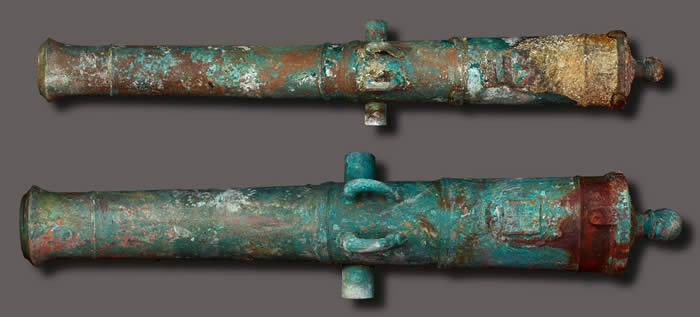The Bronze Cannon
Cannon in situ on the Victory site |
The First Rate Royal Navy warship Victory was unique as the last recorded warship lost carrying a full complement of bronze cannon. Shortly after being built, bronze guns were phased out on newly constructed English warships in favour of less expensive iron. Historical records indicate the Victory carried up to 110 bronze cannon.
The cannon scattered across the wreck of the Victory are the site's most striking feature. So far, 50 guns have been identified. These tools of war were not merely functional. With their elegant dolphins and intricate cast crests, they reflect the exceptional bronze craftsmanship of the age. A full report detailing the Victory's bronze guns and their casting is available here.
Victory 1744 is the only shipwreck ever discovered with 42-pounder cannon, the most powerful and prestigious guns used in naval warfare. All 28 of the Victory's lower-deck 42-pounders, and other guns, were cast between 1722 and 1734. No comparative collection survives in museum displays or storerooms. With the permission of the UK Ministry of Defence (MOD), Odyssey recovered one 42-pounder from the wreck in 2008, which is now the only known example in existence on land worldwide.
With MOD permission, Odyssey also recovered a 12-pounder cannon in 2008. The base ring clearly bears the maker's name, 'SCHALCH,' representing the work of master founder Andrew Schalch, the first royal appointee to the Royal Brass Foundry in Woolwich (1716-1770). Schalch personally oversaw manufacture of the guns commissioned for HMS Victory. A conservation report about the recovered 12 and 42-pounder cannon can be read here.
The presence of 42-pounder bronze guns bearing the royal arms of King George I led to the conclusive identification of the site as the long-lost early Georgian warship the Victory.
Construction of HMS Victory commenced in March 1726, the final year in the reign of King George I. The bronze cannon on the site dating to his reign indicate that the guns were ordered before construction of the ship began.
In terms of volume and unity from a single commission manufactured by Andrew Schalch at the Royal Brass Foundry in Woolwich, the Victory's guns are unparalleled in surviving collections. They are also extremely rare examples of hybrid guns designed by Colonel John Armstrong based on the former Borgard system and a master template obtained from the French.
 |
(Top cannon) 12-pounder: L. 3.12 m (10.24 ft.) muzzle diam. 11.5 cm (4.5 in.) trunnion diam. 11.5 cm (4.5 in.) Decorated with the royal arms of King George II (ruled 1727-60). |
